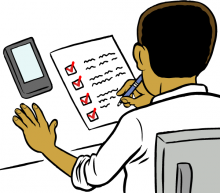 When you are in the middle of shooting your video it may be difficult to know exactly what you should record. This is particularly true when you are starting out. It is easy to get frustrated, confused, and be unsure of yourself.
When you are in the middle of shooting your video it may be difficult to know exactly what you should record. This is particularly true when you are starting out. It is easy to get frustrated, confused, and be unsure of yourself.
Every videographer has gone through this. You will get better with practice. Do your best to remain calm, focus on the task at hand, and you will find success.
Keep three guidelines in mind while you are shooting to become an effective videographer.
- Have Purpose
- Have Control
- Have Confidence
Have Purpose
- Know what you want to record.
- Pay close attention to what action or subject you intend to record, and make sure you can see it clearly in the frame.
-
Hold your position while recording
-
Allow the action within your frame to be the source of motion. This will make it easier for the viewer to focus. Make a decision on the best place to record from and hold your frame.
-
Have Control
- Hold your camera steady
- Use your body to brace the camera, the individual above uses the side of their body to brace the camera, while centering it in front of them.
- Remember to breathe. You may be tempted to hold your breath to keep the camera from moving, but its best to set your shot, breathe, and when you have a steady shot, begin recording.
- Do not pan
- Moving the camera creates a lot of motion in the frame. This is often more distracting than helpful. If you want another angle, stop recording, change your frame, and start recording your new shot.
Have Confidence

- Have a goal for your shot
- Knowing what you are trying to record before you begin will allow you to know when you have completed the shot.
- Do not stop recording until actions have completed.

- Stand in front of what you want to film, not off to the side
Things to Remember
- The more you keep these in mind, the more effective your footage will be.
- The only time to not follow these guidelines is when they will put you or your subject at risk.